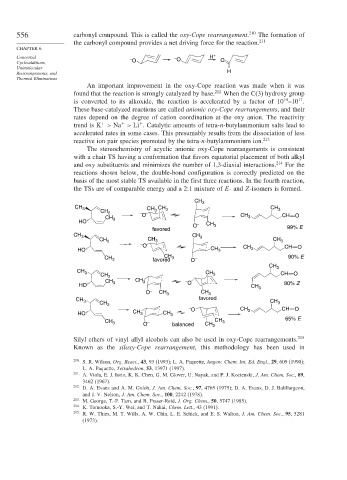Page 582 - Advanced Organic Chemistry Part B - Reactions & Synthesis
P. 582
556 carbonyl compound. This is called the oxy-Cope rearrangement. 210 The formation of
the carbonyl compound provides a net driving force for the reaction. 211
CHAPTER 6
Concerted – – O H +
Cycloadditions, O O
Unimolecular
Rearrangements, and H
Thermal Eliminations
An important improvement in the oxy-Cope reaction was made when it was
found that the reaction is strongly catalyzed by base. 212 When the C(3) hydroxy group
10
17
is converted to its alkoxide, the reaction is accelerated by a factor of 10 –10 .
These base-catalyzed reactions are called anionic oxy-Cope rearrangements, and their
rates depend on the degree of cation coordination at the oxy anion. The reactivity
+
+
+
trend is K > Na > Li . Catalytic amounts of tetra-n-butylammonium salts lead to
accelerated rates in some cases. This presumably results from the dissociation of less
reactive ion pair species promoted by the tetra-n-butylammonium ion. 213
The stereochemistry of acyclic anionic oxy-Cope rearrangements is consistent
with a chair TS having a conformation that favors equatorial placement of both alkyl
and oxy substituents and minimizes the number of 1,3-diaxial interactions. 214 For the
reactions shown below, the double-bond configuration is correctly predicted on the
basis of the most stable TS available in the first three reactions. In the fourth reaction,
the TSs are of comparable energy and a 2:1 mixture of E- and Z-isomers is formed.
CH 3
CH 3 CH CH CH
CH 2 – 3 3 3
CH 3 O CH 3 CH O
HO CH
O – 3
favored 99% E
CH 3 CH 3
CH 2 CH 3 CH 3
– O
HO CH 3 CH 3 CH O
CH
CH 3 favored 3 O – 90% E
CH 3
CH 3 CH
CH 2 3 CH O
CH CH 3 –
HO 3 O CH 3 80% Z
O – CH 3 CH 3
CH 3 CH favored CH 3
2
– O CH CH O
HO CH 3 CH 3 3
CH 3 O – balanced CH 3 CH 3 65% E
Silyl ethers of vinyl allyl alcohols can also be used in oxy-Cope rearrangements. 215
Known as the siloxy-Cope rearrangement, this methodology has been used in
210
S. R. Wilson, Org. React., 43, 93 (1993); L. A. Paquette, Angew. Chem. Int. Ed. Engl., 29, 609 (1990);
L. A. Paquette, Tetrahedron, 53, 13971 (1997).
211 A. Viola, E. J. Iorio, K. K. Chen, G. M. Glover, U. Nayak, and P. J. Kocienski, J. Am. Chem. Soc., 89,
3462 (1967).
212
D. A. Evans and A. M. Golob, J. Am. Chem. Soc., 97, 4765 (1975); D. A. Evans, D. J. Balillargeon,
and J. V. Nelson, J. Am. Chem. Soc., 100, 2242 (1978).
213 M. George, T.-F. Tam, and B. Fraser-Reid, J. Org. Chem., 50, 5747 (1985).
214 K. Tomooka, S.-Y. Wei, and T. Nakai, Chem. Lett., 43 (1991).
215
R. W. Thies, M. T. Wills, A. W. Chin, L. E. Schick, and E. S. Walton, J. Am. Chem. Soc., 95, 5281
(1973).

